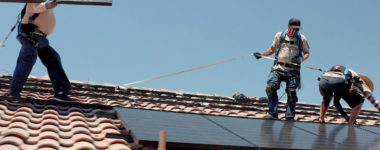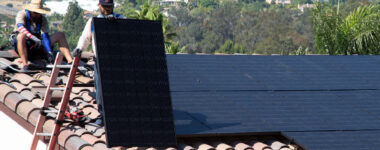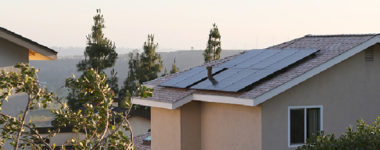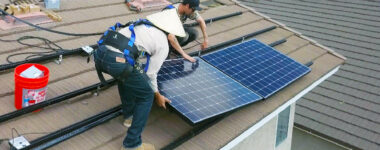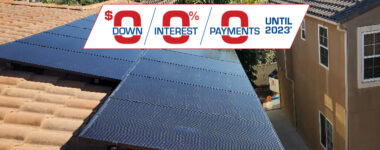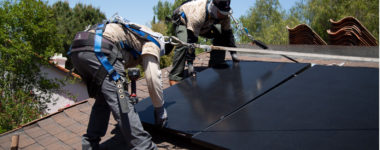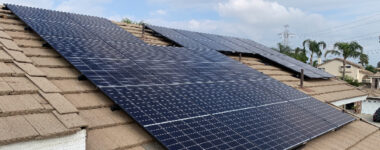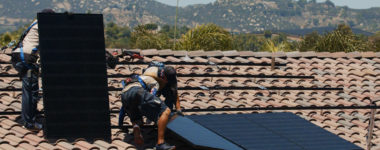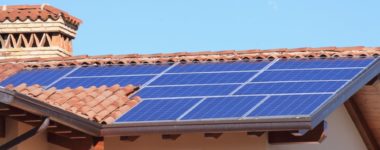Semper Solaris Blog
For most people in America, finding ways to save money is big, especially for those who are living on a fixed income. If you are in the phase of life where you want to save as much as possible so that you can stretch your fixed income out, switching to solar can be a major help in keeping your monthly electricity bill low. In some cases, your solar panel system may generate enough electricity to cover your summer and winter months (especially in sunny California), meaning you’d owe zero balance at the end of the year. While solar requires an upfront investment, it quickly pays for itself over time. Do You Know How a Solar Panel System Impacts Your Bills? Switching to solar can be great for savings, however, if you don’t know your local utility billing rules, you could be left scratching your head when you get your yearly bill. Consider an incident that happened in 2013 when a man didn’t fully understand how PG&E was going to bill him for power generated by solar, nor how to read his bill when it came in. Mistakenly, he assumed that his solar panels would help cover the cost of heating his swimming pool. Since he never had a bill that surpassed $35, he assumed all was fine – until he got hit with a massive $7,228.32 bill in July. No, he didn’t use an inordinate amount of energy that month, he just never realized he wasn’t actually getting billed for his electricity usage each month, as solar customers get a yearly electric bill, known as a True-up bill. The other bills show electric power consumption of a system vs. the actual consumption, allowing a customer to have an idea of how they are doing and what they will owe. Since he didn’t know how to read this, he was essentially oblivious to the fact that he’d owe such a big amount. Being on a fixed income, the man was concerned and confused over how we could owe this much. Unfortunately, he had also greatly overestimated the energy production of his solar panel system. The solar company had set him up with a system to cover his pre-pool electrical usage, however, the man had later decided to install a pool that he had heated numerous hours a day. Once the man realized his mistake, he began to cut back on his usage. Ensure Your Solar Investment Protects Your Fixed Income So what’s the takeaway? If you want a system that helps you actually cut back on energy costs or have a zero balance, make sure you are clear with your solar panel provider what your energy needs are. If you decide to upgrade your home, it is important to have an understanding of how much solar energy your panels are producing and what they can cover.
The United States is currently the largest consumer of oil in the world, accounting for an average of 19.6 million barrels of crude each day. This dependence on oil lends to some serious problems for the U.S., not to mention the major price tag. The country’s heavy dependence on foreign oil greatly undermines many of our economic goals and puts a dark cloud over many of our military decisions in the Middle East. Politics aside, America’s economy as a whole has become very vulnerable due to this oil dependency. In 2016, the U.S. was still importing around 7 million barrels of oil a day from foreign sources ranging from Africa to the Middle East according to former Shell Oil CEO, John Hofmeister. That means spikes in prices can develop quickly over any type of international disruption – and remain essentially out of the control of the U.S. So what is the solution? An extremely diligent and concentrated effort to replace any sources of foreign oil with alternative options from within the U.S. This is where solar energy comes into play. Energy Independence Could be Bought with Solar Power While we may be far off from being dependent on renewable energy, our country needs to start taking these strides now if we want to be free from international oil dependency. It may look like a combination of several fuel options, from natural gas to hydrogen to wind energy to solar energy. The goal would be to diversify within the U.S., rather than outside of it. Not only is foreign dependence a problem, but our heavy dependence on fossil fuels is creating a major pollution problem. Our environment and ecosystems are facing dire consequences due to oil dependency. As the largest consumer of oil, the U.S. needs to recognize this problem and take steps to reduce oil consumption in order to protect and preserve the planet. How would solar benefit the country? Freedom from international oil dependency and connected politic challenges Reduction of harmful greenhouse gases and air pollution Improvement in cost effectiveness of energy sources as a country Savings for individual homeowners utilizing renewable energy Over time, renewable energy sources like solar essentially pay for themselves and run on an infinite power source. In comparison, fossil fuels require an extensive process, are finite, and consume much more of our other valuable resources (like water) along the way. If our country wants its energy independence back and to ensure future generations have a healthy environment to live in, we must continue to embrace renewable energy sources like solar. As a veteran-owned company, Semper Solaris is proud to be doing our part to not only safeguard our environment, but also free up our country from foreign oil dependency! Call us today to get insight on switching to solar today.
In 2017, there were 20.4 million veterans, of which 370,000 were reported to be unemployed. While the percentages of unemployment are declining in recent years, it is still clear that many challenges remain for men and women returning from service. Coming “home” isn’t always as easy as we would like to believe for those who have dedicated their lives to protecting and serving our country and the freedoms we all get to enjoy. As a former Captain in the US Marine Corps, Kelly Shawhan, co-founder of Semper Solaris, knew this problem was too serious to overlook. Being in the business of solar power, Shawhan and co-founder John Almond already placed great stock in supporting the environment and providing affordable energy solutions to the local community. They saw their business as an opportunity to create another channel of support for the community by striving to hire as many veterans as possible. Solar Creates Veteran Unemployment Solutions Semper Solaris has seen significant growth over recent years, especially as renewable energy sources like solar begin to become more popular. For example, the U.S. installed an estimated 10.6 gigawatts (GW) of solar PV capacity in 2017 alone. The total is expected to double over the course of the next 5 years, with 2023 seeing estimates of more than 15 GW of PV capacity installed on an annual basis according to the Solar Energy Industries Association. So what does this have to do with veterans and their unemployment rates? Solar is a booming job market, one that Semper Solaris has not overlooked. We stand by our commitment to create more jobs for veterans, especially as the market for solar continues to grow. We have every branch of service represented by our staff. Our vets truly set our company apart, not just because of their dedication to their craft and impeccable work ethic, but also in the way that they raise the bar for our entire team. While not all the members of our staff our veterans, Shawhan views them all as his marines. The mindset of every employee is influenced by our military roots. Shawhan has confidence in each and every one of his team members, proudly stating that he has “no problem being in a foxhole with any of them.” Honored to Have a Loyal Group of Veterans on Our Team Don’t misunderstand – hiring veterans isn’t an act of charity for Semper Solaris, it’s a wise business decision. Why? Because we know that veterans are hard workers who we can trust to get the job done right and never quit. We want to employ the best, which is why we look to service members to become a part of our staff. We love being able to employ some of the sharpest, most highly trained, caring, dedicated, and loyal individuals. The fact that they are veterans is what makes them the best of the best; something Semper Solaris knows that not nearly enough companies recognize. As a veteran-owned solar company in San Diego, we take pride in having products that are designed in America and installed by highly trained professionals, many of whom are veterans. We know these individuals don’t just “deserve” a quality job, but have earned it. We are honored and proud to be able to provide a home for so many hard working and sacrificial veterans.
For many people, saving the planet or helping the environment sounds like a good thing, they just don’t know where to start. Even if you aren’t sure that “going green” is something you really want to do, consider this: helping the environment doesn’t just save the planet, it helps save your quality of life. Since you are daily breathing in the air from your environment, wouldn’t you want to keep it as clean and “green” as possible? Solar energy has numerous benefits, including the ability to help decrease respiratory and cardio health problems. That alone should be motivation enough for homeowners to go solar – and then you add in the cost-saving perks and things start to sound too good to be true (trust us, it’s the real deal). Check out some of the environmental benefits of installing solar panels below! How Solar Energy Is Paving the Way for a Better Tomorrow Better Air Quality Nothing like being able to breathe easy, especially in Southern California. Wouldn’t it be nice if we didn’t have to worry about the quality of air we breathe every day, but could just know it was clean and pure? Solar energy moves us towards a green source of energy, putting a stop to so many of the harmful air pollutants we are subject to when we step outside our homes. According to an analysis done by the National Renewable Energy Laboratory, if solar become the major energy provider, it would create a major reduction of sulfur dioxide, nitrous oxides, and other harmful emissions that lead to health concerns. Reduced Pollution & Consumption of Water Sources Did you know that natural gas and coal energy plants are reliant on large amounts of water to create their energy sources? In comparison, solar panel manufacturing only requires a minimal amount of water. After that, they don’t require any valuable local water sources to provide electricity to homes. Switching to solar would cut back on the water-sucking cooling requirements of biomass and geothermal power plants, eliminating competition with drinking water, agriculture resources, and more. Especially in California, we know that water is a precious resource that can’t be taken for granted – especially in times of drought. Solar energy can help eliminate the large usage of water simply to create power resources. Cuts Back on Emissions of Greenhouse Gas We all hear about how bad greenhouse gas emissions are, but what can we do to fix it? By opting for solar power to generate our electricity instead of harmful fossil fuels, we can cut back on the emission of gases like CO2, which can lead to rising temperatures on the planet, creating a more drastic climate change. The U.S. Energy Information Administration found that a household that switches to solar power instead of fossil fuels can have a similar impact as planting 150+ trees (depending on the region). For example, an average home in New York uses around 7,092 kWh of electricity on a yearly basis – that would require roughly 5,250 pounds of coal to be burned per year to produce just that single home’s energy. Imagine if all the homes in New York switched to solar and were able to cut back that much on greenhouse gas emissions? More than that, solar energy is a renewable source of energy, rather than a finite one. The sun’s energy can be used repeatedly without any fear that it will run out like fossil fuels. The sooner we become dependent on infinite solar energy rather than finite alternatives, the better. Don’t wait any longer to start doing your part for the environment. Go solar today and go green. Contact Semper Solaris if you have questions about switching to solar.
These days, it seems like solar panels are everywhere — especially in Southern California. The large number of homes with solar panels in Los Angeles may be attributed to our ideal climate, along with state or local initiatives that encourage solar installation. Los Angeles, the second-largest city in the U.S., ranks #2 in the nation for most solar energy systems installed. At the end of 2016, the city had 267 megawatts of total solar installed, falling just behind San Diego, at 303 megawatts. For those looking to live in the Los Angeles area, here are the top neighborhoods for solar based on a combination of factors, including solar saturation (the amount of solar homes out of the total houses in a zip code) as well as key attributes that contribute to the overall quality of living. Santa Clarita The town of Santa Clarita has a solar saturation of 21.2%, making it the third most saturated neighborhood for solar panels in the Los Angeles area. With 225,000 residents and 6,000 business owners, the L.A. suburb is booming with life; CNN Money Magazine even deemed it “one of the best places to live in California.” Santa Clarita is distinguished by its award-winning schools, and the town boasts extensive trail systems, and culture and recreational programs that make it especially enjoyable to live in. For those looking to buy, the median home value is $417,400 and average rent sits around $1,650. Additionally, the residential demographic holds an A+ rating based on ethnic and economic diversity. The Santa Clarita neighborhood of Valencia, in particular, is the most solar-saturated zip code in all of Los Angeles. Not only is solar panel installation for Los Angeles’ already-high standards extra prominent here, it’s a great place to settle down. Castaic Just south of Santa Clarita, still within the northern part of Los Angeles county, is the suburb of Castaic. Here, nearly 15% of homes have solar panels. Los Angeles County residents that reside here are surrounded by alternative energy, as Castaic Lake — part of the California Water Project — is the site of a hydro-electric power plant. The town has a population of more than 19,000 with a median home value of $425,200. Median rent is $1,346 and the median age of its residents is 36 years old. It’s known for its good public schools, diversity and being a top place to raise families. Manhattan Beach For Manhattan Beach, one of the top beach towns in Los Angeles, the sun is no stranger. It’s one of the most affluent neighborhoods in the area, with a median home value of $1,537,200. Manhattan Beach also falls into the top 10 in California for the categories of “Best Places to Retire,” “Best Suburbs to Live,” and “Best Suburbs to Raise a Family,” according to Niche.com. Its top-rated schools make it appealing for families, its bustling nightlife attracts the urbanites, and, business professionals frequent the area thanks to its close proximity to LAX. Solar panels in this Los Angeles beach-town complement the nature of the area; while the cost of living is higher, residents look to solar energy as a way to save — and capitalize on the abundant sunlight. Glendale Glendale is the third largest city in Los Angeles County and is considered one of the most livable areas. It’s home to nearly 200,000 residents and ranks in the A-grade category for public schools, diversity, nightlife and families (it was even deemed one of the safest cities in America by the FBI!). The L.A. Zoo, Norton Simon Museum and hiking trails in the San Gabriel Mountains are some major attractions nearby. Solar panels for Los Angeles residents that reside here are a viable option and way to save on electricity bills in your median $809,000 home, and you’ll fit in with your eco- and health-conscious neighbors. In fact, Glendale ranks #13 among the “Healthiest Cities in America” and the “Healthiest Places to Live in America”. South Pasadena Just six miles from downtown Los Angeles, South Pasadena ranks #15 as the “Best Suburb to Live in California”. It’s known as the City of Trees (21,000+ to be more exact), which plays well with its environment-friendly theme that welcomes solar panels. Los Angeles residents that reside here will find a charming community known for its stunning homes, robust small business economy and top-notch schools. Homes here have a median value of $876,900, with average rent around $1,500. Find Your Solar Panel Installer in Los Angeles These neighborhoods for solar installation in Los Angeles have earned their spot at the top. Their overall high livability and other friendly features make them very attractive to those looking to settle in Los Angeles; but since L.A. is known for its dense population and high pollution levels, it’s important to consider installing solar panels. Los Angeles residents not only are able to reduce their carbon-footprint by investing in solar energy, they can invest in improving the overall quality of air in the area. Ready to join them? Learn more about Semper Solaris, the #1 trusted solar company in Los Angeles.
If you live in Chula Vista, you’ve probably considered joining the ever-growing community of solar-powered homes and businesses. Semper Solaris offers information on switching to solar in San Diego County by helping you get the financial support you need to get started. We’re happy to offer guidelines on where to find financial assistance to support your switch to solar energy. For starters, the staff at the Public Works Department is always ready to provide up-to-date information on solar financing and incentives. Switch to solar panels and enjoy a clean, renewable energy source that makes a difference on your home’s energy usage and utility bills. Federal Solar Incentives – Tax Credits Taxpayers are eligible to apply for a Residential Renewable Energy Tax Credit or a Business Energy Investment Tax Credit that can be equal to 26 percent of costs related to photovoltaic panel system installation. For more information on incentives related to solar, San Diego residents can find more information on our website. Property Assessed Clean Energy Programs (PACE) PACE offers low-cost, long-term financing for energy-saving projects like solar system installation, repaid as a special assessment/tax on your regular property tax bill. Semper Solaris can help you confirm eligibility, which is based on equity and ability to pay, through Ygrene Energy Fund. Secured Financing Semper Solaris offers secured financing through local credit unions, including Metropolitan Federal Credit Union and Point Loma Credit Union. With this type of financing, homeowners use their home as collateral for the loan. Typically, these loans provide lower interest rates than unsecured loans, and the interest is usually tax-deductible. Federal Housing Administration 203(k) Rehabilitation Loans are mortgage programs provided through lenders that have been approved by the Federal Housing Administration (FHA). These mortgages are intended for various home upgrades, among other photovoltaic (PV) systems. PowerSaver Loans (which can be both secured and unsecured) that can amount to $25,000 are intended for single families who want to have small to moderate home improvements aimed at better energy-efficiency and renewables. Unsecured Financing Fannie Mae Energy Loan is a direct, unsecured loan for energy-efficiency home improvements in the maximum amount of $20,000. The loan has a fixed rate, low interest and quite long pay back terms in comparison with bank loans. Clean Energy Upgrade Financing Program ABX1 14 is an unsecured loan for residential and small commercial property. This program targets owners who want to install renewable distributed generation, the infrastructure for charging electric vehicles or energy- and water-efficient systems. The program can provide financing up to $25 million through the California Alternative Energy and Advanced Transportation Financing Authority (CAEATFA). Third Party Ownership Solar Power Purchase Agreements (PPA) are arrangements in which the customer sites a solar panel system and buys the electricity at a low cost from the third party that owns, maintains and operates the system. The benefit for the customer in this case is the zero-out-of-pocket aspect for installation costs. Solar Lease Programs are very similar to the previous arrangement, but in this case the customer pays a fixed monthly amount regardless of the energy used and is responsible for operating, monitoring and maintaining the system. Other Methods of Financing Feed-in Tariff allows the owner of the renewable distributed generation to get a refund for the electricity they produced but sent back to the utility grid because they didn’t need it. Virtual Net Metering is designed for multi-metered properties. Production credits form one PV system can be sent to individual homeowners. Are you ready to go solar in San Diego County? Contact us to learn about going solar and see how much you can save on our highest efficiency solar panels.
California is a big state filled with big ideas and great people. Here in the Golden State, we’re not afraid to take the lead in tackling thorny problems or try innovative solutions. You could say that our “sunny” disposition inspires us to embrace new ideas. So it’s no surprise that we were one of the first states to recognize the potential of solar energy to combat climate change, or that we’re recognized as #1 on SEIA’s Top 10 Solar States list, producing more megawatts (MWs) of solar power than the next nine states combined! In this article, we’ll take a look at the history of California solar power. How did our state become the leader in producing and utilizing solar energy, and what does the future have in store? Power from the Sun If you were to take a helicopter tour over any major city in California, you would notice the sheer number of solar panels dotting the roofs of homes and businesses. Where did these panels come from? The history of California solar starts in 1839, when French physicist Alexandre Edmond Becquerel discovered the photovoltaic effect, demonstrating that a solar cell could convert sunlight into electricity. A few decades later, American inventor Charles Fritts designed the world’s first solar array, but it would still be a long time before solar panels landed on any roofs. Bell Labs patented the first silicon-based solar cells in 1954, and Hoffman Electronics-Semiconductor Division developed the first commercial solar panel the next year. This baby boasted a measly 2% efficiency rate! Just to compare, today’s top-rated solar panels can give you a 17% to 20% efficiency rate depending what brand you use. In these early days, solar panels were mostly just an idea stuck on a drawing board. It would take a major world event and open-minded politicians to truly spark the California solar energy movement. Oil and Blood The 1970s saw great unrest in the Middle East, which led to the Iran hostage crisis and the Arab oil embargo. At home, oil prices soared, and images of long lines of cars waiting at gas stations splashed the front pages of newspapers. In response, President Jimmy Carter made energy policy a hallmark of his administration. In 1978, Congress passed the Public Utility Regulatory Policies Act (PURPA), which was designed to promote energy conservation and laid the groundwork for net metering. As part of the act, PURPA allowed independent power producers the ability to interconnect with their local utility. In the same year, Congress also passed the Energy Tax Act, which offered the very first tax credits to consumers who invested in renewable energy for their homes. Carter even famously installed solar panels at the White House. Even though the solar panels came down and the tax incentives were phased out by Ronald Reagan, these early laws woke Americans up to the possibility of solar energy. They also helped encourage the creation of wind and solar energy companies, which found a very friendly reception in California. (Interesting to note: solar panels were eventually installed once again at the White House, this time under President Barack Obama.) California Sun More than any other state, California embraced the potential of solar power even in the industry’s nascent beginnings. In 1979, ARCO Solar broke ground on the world’s largest photovoltaic facility in Camarillo, California. ARCO’s project was soon followed by others, including a 6 MW facility in central California, the construction of solar towers, and an attempt to build the world’s largest solar thermal electricity facility in the Mojave Desert, known as the LUZ Solar Energy Generating Stations. Not all of these projects were a success. Some ran out of money and others were eventually closed down due to disappointing results. Some observers believed that solar would never be more than a fringe power source, just another big California dream that went nowhere. However, these early stumbles didn’t deter California. Producers learned from each trial, and as solar technology improved and costs decreased, more ambitious solar projects got underway. As of this writing, California is home to a variety of big solar projects, including the Desert Solar Farm in the Mojave Desert, the California Valley Solar Ranch in the Carrizo Plain, the Mount Signal Solar project near Calexico, and the Topaz Solar Farm in San Luis Obispo County, which was the world’s largest photovoltaic power plant when it was completed in 2014. While ARCO’s original solar facility in 1979 produced just 1 MW a year, these facilities produce between 260 to 550 MW per year! California can also brag about being home to the world’s largest solar thermal power project, the Invanpah Solar Power Facility, which was completed in 2014. It resides in the Mojave Desert and produces 392 MW per year. The Mojave Desert is also home to the Solar Energy Generating Systems, the Genesis Solar Energy Project, and the Mojave Solar Project, which together produced 71.2% of all solar thermal generation in the United States in 2015. None of these projects would have been possible if California hadn’t aggressively supported investment in renewable energy and forged a path toward a carbon-neutral future. Taking the Lead California was once known for the debilitating smog that choked its cities and its people. These days, it’s earned a new reputation as a state that has passed some of the most ambitious and progressive energy laws in the country. It may have started in 1996 with the Electric Utility Industry Restructuring Act (Assembly Bill 1890) signed by Governor Pete Wilson, which deregulated the state’s utility companies and incentivized them to adopt net metering policies. Without net metering, which allows homes and businesses to feed excess solar energy into the grid, solar panels in California would likely never have taken off. AB 1890 also created state rebates to reduce the cost of this expensive new technology. Perhaps the biggest boost to California solar energy came in 2006, when Governor Arnold Schwarzenegger signed the California Solar Initiative, which offered rebates to residents who invested in solar energy technology. The goal of the initiative was to install 1,940 MW of new solar generation capacity by 2016. It worked out so well that the state exhausted its incentives two years early, and the program surpassed its production target. (Don’t worry, there are still plenty of ways to save on solar panels in California.) The California Solar Initiative was followed in 2015 by the Clean Energy and Pollution Reduction Act (Senate Bill 350) signed by Governor Jerry Brown. SB 350 stipulates that California must produce half of its power from renewable sources by 2030. This is an incredibly ambitious goal, but if anyone can do it, we know California can. Our state produced 18,296 MW of electricity in 2016, which was enough energy to power more than 4.7 million homes in our state. As solar panels in California continue to become more efficient and more affordable, we know these numbers will keep going up! The Future of California Solar Power What’s in store for California’s solar future? Will we produce half our power from renewable resources by 2030 and meet the mandate of the Clean Energy and Pollution Reduction Act? Currently, several big photovoltaic solar farms are in production, including the Blythe Solar Power Project in Riverside County and the California Flats Solar Project in the Cholame Hills, which will produce even more solar energy for our state. As for Sacramento, we won’t be surprised if our state sets more aggressive goals for renewable energy output. In 2017, senate leader Kevin de León introduced the 100 Percent Clean Energy Act, which set the target for California to receive all its energy from clean energy sources by 2045. The bill was dropped at the last minute, but many assume the bill will be presented again during this year’s legislative session. Here at Semper Solaris, we are proud to help California meet its renewable energy goals. We can learn a lot from our state’s history, but we’re also excited to see what the future of California solar power brings. Help us make that future by scheduling a free energy audit today.
Did you know there are unique considerations to take when it comes to San Diego roofing? Although the city is known for its ideal, sunny weather, the climate may vary depending on the area of San Diego you live in. Inland residents often experience higher temperatures, while those living coastal experience daily marine layers that burn off throughout the day. And while San Diego is technically a desert, rainfall is still a factor that influences rooftop decisions. If you live in San Diego, take the following considerations into account for your roofing needs. Heat-Friendly Rooftops The warm climate is one of the major appeals of living in San Diego. Roofing, because of this, needs to be able to handle the constant sun and hot temperatures in the summer, especially for inland regions like East County. Make sure you have a heat-friendly rooftop, also known as a “cool roof,” which helps to cool the home more efficiently. They usually are lighter in color so, as darker colors tend to absorb heat, and are often made of materials that reflect the sun. There are a few different ways to make a roof a “cool” roof. Clay and terracotta tile roofing is ideal for desert climates because it blocks heat. Slate tile is another good fit for your roof because it doesn’t require a lot of maintenance. It comes in light and earthy colors that are naturally reflective and durable. Energy-Efficient San Diego Roofing San Diegans can bask in sunnier-than-average climate. And they can capitalize on the sun by installing solar panels on their rooftops. Solar panels soak up the sun’s energy and convert it to power for the home. These panels should be durable and use the latest technology, so when you have your solar panels installed be sure to communicate these needs to your solar installation company. It's also just as important to ensure that your roof has proper insulation. Since 25% of heat in a home leaves through the ceiling, your roof is a key player in stopping this during the colder winter days in San Diego and at night when the temperatures drop significantly. Properly insulated San Diego roofing equates to energy-efficient homes, so you save on your utility bills. Poorly ventilated rooftops are not ideal for hot weather. They can transfer heat into the living areas and increase air-conditioning consumption, if you’re using one. For those living inland who turn on the AC in the dog days of summer, this can be especially a concern. Proper roof ventilation also helps in the winter, working to prevent moisture damage — especially if you live near the ocean or bay. Timing of San Diego Roof Installations Luckily, San Diego’s mild climates year-round make Roof Installations easier to execute. Fall is usually the busy season for Roof Installations and costs tend to go up due to demand, so consider getting the repair work done in the off-season if it can wait. Another benefit to having your Roof Installationed in the off-season is that it can make for a less stressful situation, because you won’t be behind a waiting list of customers. This is particularly important when making major decisions that involve your roof; a clear mind means the proper steps and considerations can be taken when consulting with your roof installation and repair company. San Diego Roofing with Wildfire Protection Wildfires are an unfortunate reality San Diego homeowners may face. The Southern California region experiences wildfires from time to time, and the dry desert climate further fuels the potential for fire to spread rapidly. Homes located on or near slopes of hills and valleys have a higher risk of getting affected. While location is hard to change, one thing these residents can do is install outdoor sprinkler systems. These sprinklers work to prevent the spread of embers when they come in contact with a house, keeping it protected and safe. Roofing Maintenance in the Winter Although San Diego has mild winters in comparison to other regions of the U.S., it occasionally experiences significant temperature drops. Winter nights can drop to 40- or sometimes 30 degrees Fahrenheit, which can create frost and condensation when it warms up during the day. These conditions can cause mold to grow on your roof during the winter months, especially on flat roofs. Leaves may pile up on your rooftop when the wind blows, and these piles then collect moisture from winter frost. This combination can eventually cause organic growth to form on the roof surface. To prevent mold from forming, make sure you regularly clean your roof and sweep away the leaves. Making Smart Decisions for Your Roof While you may not think the weather in San Diego would have an influence on how you should go about roofing matters, think again! The signature climate does call for special considerations to be made to ensure that your rooftop is both energy-efficient and long-lasting. Plus, doing so will help you avoid having to make extra repairs to your roof. For further information on how different types of materials, installation, and maintenance impacts your roof, check out some more details on San Diego roofing, and see how Semper Solaris can help you meet the needs your roof requires.
Installing California solar panels is a smart choice that will harness the power of the shining West Coast sun and transform it into useful electricity to power homes or businesses. At Semper Solaris, we are proud to staff many veterans, giving them a career they can be proud of as well. We hire veterans from all branches, and Semper Solaris wouldn’t be the same without them. We hire veterans for two important reasons. First, co-founder Kelly Shawhan committed to helping veterans during his service in the United States Marine Corps. Kelly made a promise with thirteen other Marines during a mission in the Philippines in 1985. He committed to always help out a fellow Marine or service member whenever he could. Now, he carries that promise into his solar company, Semper Solaris. There’s another reason that Semper Solaris hires veterans: veterans do excellent work. The military instills values and skills that carry well into the California solar energy industry. For example, veterans know the value of keeping their word and being faithful. They also know how to communicate within a chain of command. They understand loyalty, and remain loyal to employers and the families that they serve. Loyalty and faithfulness translate to installing solar panels the right way. The skills that veterans learn in the military can translate to all sorts of jobs within the renewable energy industry. Army E5 Sergeant May Lin Ball and Navy Petty Officer Second Class E5 Tony Saludes both now serve as accounting clerks with Semper Solaris. Semper Solaris employee Marilynn Raptis was an Information Systems Technician Chief on submarines for the United States Naval Reserve. Now, she is an excellent solar warehouse technician. These team members use the character that they built during their service to provide quality, dedicated service. They’re also able give this to homeowners at a great solar panel price. These skills, along with their specific photovoltaic training, help them to install amazing California solar panels. About the Marines, Kelly shares, “It isn’t even so much that your word is your bond—it’s that your word is a fact.” Being able to stick to your word is needed in any home industry, especially solar power. The Semper Solaris team works hard to keep their word. David Fox, for example, is the fleet warehouse and facilities manager. He is also a retired Sergeant Major with the United States Marine Corps Reserve. David helps ensure that the warehouse runs like a well-oiled machine. He uses a proper chain of command similar to the military’s to help the company deliver. Semper Solaris’ commitment to the nation’s veterans is more than hiring them to solar companies. They also offer special discounts to military personnel—and also to first responders and their families. Semper Solaris knows that veterans can make amazing employees. We seek to honor those that have served our country so loyally. Would you like one of our trained veterans to take their work to your home? Get a free energy analysis from local and veteran-owned Semper Solaris.
If you’re thinking about adding solar power to your San Diego home, you have a lot of choices when it comes to hiring local solar panel installation companies. So, what makes Semper Solaris different from the rest? First and foremost, we’re committed to offering our customers unparalleled service and the highest quality solar panels on the market. However, what really gets to the heart of our company is our passion for the San Diego community, our support of local veterans, and our commitment to help San Diego County and California retain its role as a renewable energy and environmental leader in our country. Veterans Hiring Veterans San Diego is a military town, and it isn’t just because we are home to top military bases, including Camp Pendleton, the Marine Corps Air Station at Miramar, and the naval bases in Coronado, Point Loma, and San Diego (homeport of the Pacific Fleet). Even after completing their service, many veterans make San Diego their long-term home. According to the U.S. Census, approximately 230,000 veterans live, play and raise their families in San Diego County. That’s the third-highest number of veterans by county in the entire country! Of course, you don’t need to rely on these numbers. You’ll see veterans everywhere: at the grocery store, jogging down the street, and moving in next door. These men and women have a special bearing, a sense of duty, and a fierce patriotism that never fades, even after they leave the service. At Semper Solaris, we love that so many veterans live in our city. We are a veteran-owned business and are committed to hiring veterans. Our co-founder Kelly Shawhan proudly served as a Captain in the U.S. Marine Corps, and knows that it can be challenging for veterans to transition into civilian life. That’s why we make a special effort hire veterans. We are proud of our workforce, which includes veterans from nearly every branch of the service. (Check out this video introducing some of the veterans on our team.) Military veterans are the backbone of San Diego, a city we love. That’s why we are especially proud to make our city a little cleaner and a little more energy-independent by offering solar power in San Diego. We’d like to think our efforts help San Diego pursue its renewable energy and environmental goals. San Diego Stays Classy and Clean California gets a lot of attention for its progressive (in fact, some might call it controversial) environmental initiatives, but we’re a big state, and each local city and county has a lot of control over their own environmental policies. San Diego may not make the headlines as often as our state, but our leaders are committed to lowering our environmental footprint and keeping our diverse county clean and beautiful for its residents. Solar energy in San Diego is a big part of these efforts. Here are just a few environmental initiatives, programs, and benefits that San Diego residents should know about. The Climate Action Plan (CAP) Perhaps the most ambitious local initiative in San Diego is the city’s Climate Action Plan (CAP), which calls for cutting all greenhouse gas emissions in the city in half by 2035. There’s one more little thing that makes the plan stand out: the city also wants to generate all of its electricity from renewable sources by 2035. This is a big goal, but as more and more businesses and homes adopt solar power in San Diego, it seems possible that we can achieve it. The CAP program is made of up of many different initiatives to try to achieve this goal, including: Expanding its Green Business Program Supporting residential and commercial environmental upgrades Assisting low-income households with weatherization and energy-efficient upgrades Retrofitting 13,000 to 15,000 streetlights with adaptive “smart” lights Public Transportation The city of San Diego isn’t the only one getting into the lower-carbon-footprint game. Throughout San Diego County, you can see efforts to encourage people to drive less. You can’t miss the iconic blue and green Sprinter Trains getting students to college and residents to work. You’ll also notice Breeze buses picking up and dropping off residents all across the county. As you get closer to the city, you’ll pass city dwellers cruising by on Discover, Lime and Byrd rideshare bikes and hear the Trolley arriving into town. Want to see where these options can take you? Here’s a convenient list of San Diego’s primary public transportation options. HOV and Bike Lanes Even if you have to jump into a car to get to your destination, San Diego County rewards you for carpooling when you can. Most of our major highways include High-Occupancy Vehicle (HOV) lanes that let you zip past traffic if you’re carrying passengers. Have an electric vehicle? You may be able to get a special pass to use the HOV lanes to your heart’s content. When you can, San Diego makes it safe and easy to switch from four wheels to two. You’ll find dedicated bike lanes throughout the city and the county on most major roadways. No wonder our city is considered a cycling destination! Solar Energy in San Diego Solar power in San Diego will play a big role in meeting CAP’s goal of producing 100% of electricity through renewable resources by 2035. Though this goal may seem “pie-in-the-sky,” it may be closer to reality than you think. A report by the Solar Energy Industries Association found that in 2016, solar “added more generating capacity than any other source of energy for the first time ever.” To us, that sounds like we’re moving in the right direction! In many ways, San Diego is following California’s lead in pushing for big changes to lower our state’s carbon footprint and combat climate change. California Leads the Way California gets a lot of attention for its environmental policies, which are often some of the most progressive and ambitious in the nation. The state is also credited with leading the way for other states to adopt similar policies. But this wasn’t always the case. In the 1940s, California was famous for something else – the thick blankets of smog that choked its cities. In response, California got to work. It became the only state to receive a waiver from the Environmental Protection Agency (EPA) to set its own emission standards. Our state hasn’t looked back since. Here’s a short timeline of our biggest environmental achievements: 2002 – California becomes the first state to approve new standards for reducing greenhouse gas emissions from cars, including the requirement for most cars to use catalytic converters. 2006 – California passes AB 32, The California Global Warming Solutions Act, which is hailed as a watershed moment in the state’s history. The bill requires the reduction of greenhouse gas emissions to 1990 levels by 2020. 2013 – California institutes a cap-and-trade program to reduce carbon levels. After early stumbles and legal challenges, the program auctioned off 64 million carbon credits in 2017 in partnership with Quebec, which raised billions of dollars for energy programs and the state’s Greenhouse Gas Reduction Fund. 2015 – Governor Jerry Brown signs SB 350 into law, which requires that California receive half its electricity from renewable sources by 2030. 2017 – In response to the United States pulling out of the Paris climate accord, California, signs onto the United States Climate Alliance, along with over a dozen other states. The Alliance commits to reducing carbon dioxide to fulfill the U.S.’s original pledge. At Semper Solaris, we are proud to put veterans to work and to stand with San Diego to support policies that will ensure a cleaner city and a cleaner state. Interested in lowering your electricity bill and helping San Diego meet its Climate Action Plan goals? If you are ready to join the movement, learn how to get solar energy in San Diego by scheduling a free energy audit with Semper Solaris.
You may not give a lot of thought to how your electrical bill is calculated, but if you have or plan to install solar panels, it’s important to understand how your electrical company measures your energy use. For Southern California Edison customers, this calculation is about to change. The current system of net metering is the more beneficial option for families with solar panels. If you want access to net metering, you should install your solar panels now so that you can lock in lower electrical rates. Read more to learn about how net metering works. What is net metering? Net metering is straightforward: the electric company measures how much energy you use from the grid, and how much energy your solar panels export to the grid. You get charged for whatever energy you use that isn’t covered by your solar panels. Let’s say that your solar panels produced more energy than you used. In that case, the electric company would actually pay you for that extra energy! However, under the new plan, you could get paid less for the extra energy that you produce! The old program for homeowners with solar panels was called NEM (Net Energy Metering). Southern California Edison has now initiated NEM 2.0, with changing rates and charges. NEM 2.0 customers will now have to be on a TOU (Time of Use) schedule, and will be charged higher rates for energy usage during peak hours—and get paid lower rates for power produced not during peak hours. Electric rates are only going up. Southern California Edison initiated a high usage charge starting January 1st. Homeowners who use much more than the average will be paying 31 cents per kilowatt hour—almost twice the amount as the lowest tier. This charge could make your bill go up significantly, and it’s not going away. If you want to avoid this high usage rate, or if you just want to stop paying ever-increasing amounts for electricity, now is the time to go solar! If you’re going solar, there’s no better option than Semper Solaris. Semper Solaris is locally and veteran-owned, and was co-founded by John Almond—San Diego resident and in the business world for over twenty years—and Kelly Shawhan, former U.S. Marine Corps Captain. We pride ourselves on our strong military values such as keeping our word, taking responsibility for our actions, and communicating clearly and constantly. We love to hire our nation’s veterans, and we also show our support for veterans by offering special discounts for military, first responders, and their families. Our solar installation experts are known for being friendly, professional, and well-trained in their abilities—so much so that Semper Solaris has earned an A+ rating with the Better Business Bureau for our outstanding customer service, not to mention our excellent ratings with customers through services like Yelp. Semper Solaris also uses the incomparable SunPower solar panels, which are designed in the United States. SunPower panels are especially durable because of a special copper backing and have won world records in efficiency. They also come with a powerful 25-year bumper-to-bumper warranty, unlike any other company’s warranty. Call Semper Solaris today to set up an appointment. One of our courteous professionals will be happy to come to your home and work with you to evaluate how solar panels might work for your home and to help you start saving money today.
It’s easy to feel overwhelmed with the onslaught of alarming climate news. The polar ice caps are melting. Hurricanes and rising oceans are swallowing islands. Wildfires in California are getting bigger and badder. Oh, and what the heck is happening to all the bees? It’s enough to make you grab a tub of ice cream and hide under the bed. Before you give up all hope, remember the power of human ingenuity. Small actions from a lot of people can add up. Earth Day is almost here, and with it comes a reminder that you can fight the effects of climate change by making smarter environmental decisions in your life. That might mean something as big as investing in California solar systems, or something as small as using fewer water bottles this year. Every action matters. In honor of Earth Day on Sunday, April 22nd, here are five things you can do to lower your carbon footprint and fight for our beautiful planet and home. Install California Solar Systems Of course we would start with this one! Here at Semper Solaris, we help homeowners lower their carbon footprint every day by installing solar power systems on their homes and businesses. San Diego is one of the best cities in the country to go solar, thanks to our abundant sunshine and progressive utility companies that offer net metering. The average family used 10,766 kilowatt-hours (kWh) in 2016. According to the Carbon Fund, one kWh equals roughly 1.22 pounds of CO2. Families that invest in California solar systems that cover their entire energy usage could save over 13,000 pounds of CO2 from hitting the atmosphere each year. That’s a big deal! Buy an Electric Vehicle Unless you live in downtown San Diego or a beach community like Pacific Beach or Solana Beach, chances are that you need a car to get around. Each commute to work, grocery store run, or doctor’s appointment emits CO2. In fact, the typical passenger car spews out 4.7 metric tons of carbon dioxide a year! If you have a long commute and/or drive a vehicle with poor gas mileage, your carbon bill will be even higher. Don’t want to feel guilty for that midnight In-N-Out Burger run? Ease your conscience with your next car purchase and consider an electric car. These days, there are plenty of models on the market, from the sleek Tesla Model S to the mid-range Chevy Bolt and Ford Focus Electric. The Mitsubishi i-MiEV or the Smart Fortwo are perfect options for the driver on a budget. While electric cars tend to be more expensive than their gas-guzzling peers, you can nab federal tax credits for purchasing one of these cars. Additionally, with a little planning, your solar power system can cover the extra electricity your new set of wheels needs! Plan a Staycation You and your family deserve an awesome vacation each year, but flying is one of the most carbon-expensive actions you can take. A trip from San Francisco to New York will produce almost a metric of CO2 per passenger, which represents roughly 20% of all the greenhouse gases your car produces in a year. Does that mean vacation is canceled this year? No way! Instead, consider keeping your vacation a little closer to home. After all, you already live in one of the best vacation destinations in the world. In California, you can create almost any type of vacation you want. Walk down Hollywood Boulevard, take the kiddos to Disneyland, visit Alcatraz, lounge on a pristine beach, or shred it on the slopes. Here’s another staycation idea: while you’re doing your part to save the planet, why not remind yourself of what you’re protecting? California is home to 28 National Parks, including: Yosemite National Park Redwood National Park Joshua Tree National Park Death Valley National Park Sequoia National Park and a whole lot more! Reduce, Reuse, Recycle Maybe you’re not ready to invest in solar panels in San Diego or pick out a new car just yet. Lowering your carbon footprint doesn’t have to be an expensive endeavor or even that lifechanging. It can be as simple as reworking your current habits just a little here and there. What are some of the things you can reduce in your life? How about plastic water bottles and paper towels? Think about whether you can save water and electricity by waiting until the washer or dishwasher is full before running a cycle. It’s difficult to determine the environmental impact of every single product, but the Carbon Fund estimates that every pound of manufactured product costs 4 – 8 pounds of CO2. Think about that the next time you stop into your local big box retailer. Before each purchase, ask yourself, “Will this make my life better?” If not, then maybe you don’t really need a 50th pair of shoes or another magazine. When it comes to recycling, it really doesn’t take a lot of effort to toss your paper, glass, aluminum and recyclable plastics into the recycling bin. If you really want to step up your game, see if any local farmers in your area are accepting organic waste for composting. There are other ways to recycle. Give old clothes and things you don’t use anymore to Goodwill or the Salvation Army. Someone else can use it, which means they won’t have to buy something new! Carbon Offsets Living a more environmentally focused life doesn’t mean you have to give up every pleasure. Most human activity generates carbon in some form. It can be easy to start feeling guilty about every trip to the grocery store, every pack of new socks, or the flight you had to take for a business trip. Guilt and fear lead to resentment and feelings of depravation. That’s not what Earth Day is about, and it’s not a great way to live your life. Instead, give yourself permission to find a balance between eco-consciousness and fulfillment. One way to do this is to purchase carbon offsets to help balance out the ways you add carbon to the environment. You’d be surprised at how affordable offsets can be. A flight from San Francisco to New York will cost less than $11 in offsets through United’s offset program. Be careful when choosing a carbon offset company. Make sure your company is verified by an independent third party to ensure that it’s using your money in a way that really takes carbon out of the atmosphere (like planting trees) or prevents carbon pollution (like donating to a wind farm). Not sure which carbon offset company to choose? The Sierra Club recommends NativeEnergy. Carbon Reduction Lighting Round Thought we were done with the carbon reduction recommendations? Not so fast! A lot of the suggestions we’ve made require big changes to your life, but even small changes can have a big impact if you keep at them over the years and convince your friends and family to join you. Here are 10 quick, easy, and cheap ways to reduce your carbon footprint that you can easily turn into automatic habits: Unplug chargers and switch off power strips when they aren’t in use Lower your thermostat one degree in the winter and increase your thermostat by one degree in the summer Keep your tires inflated Make one day “meatless” per week Order chicken instead of steak Group errands together so you don’t take as many solo car trips Carpool to work Make a commitment to walk if your destination is less than a mile away Don’t speed Use a traffic app to avoid congested roads Celebrate Earth Day Earth Day is a chance to celebrate our potential. We’ve gotten ourselves into this climate change problem, and we can get ourselves out as well. This will require human ingenuity, passionate advocacy, and changes in how we live on a global and personal scale. At Semper Solaris, we are a veteran-owned solar installation company proud to be fighting this new battle. Solar panels help our customers save money and reduce their carbon footprint. If you live in San Diego, we hope you’ll celebrate Earth Day with us and consider scheduling a free energy analysis.
With the recent Pineapple Express storm pounding California with more rain and more extreme weather than usual, homeowners might be left wondering about the effect of weather on solar panels. Here’s what you need to know about how solar panels work and how weather may affect them. How Solar Panels Work without Sun The way solar panels work is because of a cell panel that converts sunlight directly into electricity. When photons (particles of sunlight) hit them on top of a roof, the panel turns the photons it receives into electrons of direct current electricity. The inverter then converts the direct current electricity into alternating current power, which can be used to power household items. A common misconception about solar panels is that they need direct sunlight in order to work. Although the sun is the main source of energy that they absorb and convert into power, the way that it is projected onto a solar panel cell doesn’t necessarily require direct sunlight. Solar panel cells actually just need the photons emitted from daylight sun. In other words, even if it’s cloudy out, the sun’s photons are still being spread into the atmosphere and absorbed into the panels. That being said, direct sunlight is still preferred over indirect sunlight for optimal energy absorption. On cloudy days, solar panels produce only 10 – 25% of their capacity. Factors that make this range an approximation include the density of the clouds, as well as the type of solar panel; some can handle diffused light better than others. Impact of Different Weather on Solar Panels Most solar panels are built to handle a wide range of climates and conditions, including heavy rain, hail, wind, heat and cold. This is good news for areas that are impacted by storms, rain and snow. During the manufacturing process, each solar panel is tested for extreme weather conditions to receive an Underwriter’s Laboratories (UL) certification. While this certification is a good baseline, it doesn’t mean that all solar panels uphold the same durability and quality. It simply means they have passed the minimum number of tests required to be certified. More specifically, high winds, snow, and cold temperatures shouldn’t be a concern. Top-rated solar panels are engineered to withstand winds of up to 140 MPH. As for harsh winters — cold temperature can actually improve solar panel output, and white snow can reflect light and improve photovoltaic performance. So long as panels aren’t covered in snow, winter climates can actually be an ideal environment for solar panels. Snow will usually melt and slide off panels easily; if it does build up, simply use a broom to brush it off. Of course, solar panels aren’t entirely invincible. Lightning and hail can damage solar panels in extreme cases. Consumers should look into their homeowner’s insurance policy, which usually covers solar panel damage if it is not included in the solar panel’s warranty. Additionally, be aware that hot climates may actually reduce the efficiency of solar panels. For any temperature above 87 degrees Fahrenheit, a one-degree increase in temperature can equate to a 1% decrease in efficiency. Durability of Solar Panels Most inclement weather won’t have a huge impact so long as they are high quality and boast durability as one of their main attributes. Many top-rated solar panels have a proven track record of durability, degrading at a slower rate than others. In fact, the manufacturer guarantees that the system will produce 92% of its rated power after 25 years of use. Durable solar panels also protect the roof of your home from harsh weather conditions, acting like a barrier. Panels are built to hold a certain weight, so the more durable your panels, the better they can withstand snow or hail. Proper Solar Installation to Withstand Any Weather Condition One key factor to ensuring weather doesn’t become a hindrance is making sure the panels are properly installed. Your money is on the line, so make sure the solar installation company that you go with is reputable among the solar industry. The installer should understand the types of local wind patterns and climate conditions your area typically receives, and help you pick the right solar panels to match these needs. Even if you live in California where the sunnier-than-average climate is ideal for solar , it’s normal to wonder how the weather might affect their efficiency. The science behind how panels absorb photons speaks to why they still work on cloudy days, and the durability of the panels allows them to withstand just about any weather scenario. At the same time, it’s important to choose the best quality solar panels and look for an installation company that can properly install panels so that they are secure and ready to face any weather condition. To find out more about what makes a top-rated solar panel worthy of installation, start by asking these 10 Questions About Solar Panels — that way you can ensure your panels will remain sturdy on your roof, whatever the weather may be.
As you near retirement, it’s important to think about reducing your energy costs to maximize your savings. Solar is a popular option for cutting those utility bills. If you’ve done your homework and decided solar is the right choice, it’s time to ask yourself, “Who are the best solar providers near me?” Unfortunately, California households face increased electricity prices compared to other homeowners despite the fact we use about 31 percent less energy on average. Consulting with solar providers near you is the first step toward reigning in those excessive costs and keeping more money in your wallet. Discover the advantages of going solar and the available solar providers in your area. Advantages of Going Solar As you consider setting yourself up for optimal quality of life during these retirement years, your financial stability is probably one of your largest concerns. One of the biggest advantages of investing in solar during retirement is that it stabilizes your electrical spending, helping you cut out a variable cost and one of your biggest household expenses. In fact, you could be putting more than $1,000 extra back in your account every year. This allows for more enjoyment in your “golden years”! What are some other key advantages of investing in solar now? Helps reduce greenhouse gases and protect the planet for years to come Current federal and state tax credits offer great savings Greatly improves the value of your home Solar investment returns are not taxable (excluding SRECs – Solar Renewable Energy Credits) Protecting your well-being is important, and switching to solar energy can play a major role. More than that, you can help contribute to a cleaner tomorrow for future generations. With utility costs going up every year, there is no relief for Californians’ outrageous energy bills unless they switch to solar. Why Trust Semper Solaris With the Job? Not many companies treat customers with the respect, care, and attention that Semper Solaris provides. What makes us unique? We are a company that is founded on military values. These roots mean that we take your trust in us seriously. Especially for customers heading towards retirement or already there, we understand the value of every investment you make. That is why we review all your options with you, from buying the system outright to buying the system with a loan or having a solar lease. Taken from the Marine Corps motto, Semper Fidelis, Semper Solaris vows to remain always faithful in our service to you. On top of that, we offer the best prices in California and discounts for military, police, and firemen. Our locally and veteran-owned solar company is ready to tackle your solar panel installation. If you're looking for a solar provider near you, we service both the San Diego area as well as the Los Angeles area. Give us a call today if you’d like to find out more about the value of solar as a retirement investment.
One of the most common questions we get from prospective clients is: How many solar panels will I need for my house? It’s a good question, because the number of solar panels you need will of course affect the price of your solar panel installation. The number of solar panels you need for your home will depend on how much energy you typically use, where you live, and the efficiency of your solar panels. According to the U.S. Energy Information Administration, in 2016 the average U.S. family used roughly 10,000 kWh (kilowatt hours) of electricity, which would require about 16-20 solar panels. That’s the average, but you’re not average, right? In this article, we’ll help you figure out how many solar panels you need to power your life here in sunshine-rich Southern California. Your Energy Usage The first step in determining the size of your solar installation is to figure out how much energy you use. The last thing you want is to invest in a solar power system that doesn’t produce enough energy or produces more than you need. This average household data we mentioned above provides a baseline, but it might not be relevant to you. A family of six in a 5,000-square-foot home in San Marcos with a heated pool and two electric vehicles is going to use a lot more energy than a couple living in a 2,000-square-foot home in Carlsbad who don’t drive electric cars or have a swimming pool. You can find your typical energy usage by looking up your energy bills for the past year. These should be available by logging into your electric company’s customer portal. Each bill should include your total energy usage in kilowatt hours for that month. Add up the amount for the past twelve months and then divide by 12. Viola! You’ll have your average monthly energy usage (typically between 850 and 1,000 kWh). Assuming you want your solar panel system to cover all of your electricity needs, you’ll need to install a system that can produce this amount each month. Where You Live Where you live also plays a role in how many solar panels you need for your home. Americans who live in states like Washington and Maine have to endure long winter nights and many overcast days of the year. Their solar panels get less sunlight, which means they have to put more panels on their roof to produce the same amount of electricity as someone living in a sun-rich state like California. Of course, just because the sun is in the sky doesn’t mean your solar panels are producing at max capacity. For example, sunrise and sunset won’t help your panels generate much solar energy, because when the sun sits at such a low angle, the atmosphere filters a lot of the light. Also, rates of sun can even vary from house to house depending on external features (like tall trees or a big hill behind your home) that affect how much sun you get. When calculating how much electricity your solar panels can produce, it’s more important to figure out how many peak sun hours your location receives on an average day rather than just the amount of time the sun is in the sky. Without getting too technical, you can think of a peak sun hour as an hour when your panels are receiving strong, direct sunlight. (If you do want to get technical, a peak sun hour is when the intensity of sun is 1,000 watts per square meter.) In the U.S., most areas receive an average of three to five peak sun hours per day. When you schedule your energy analysis with a solar installation company, an energy expert will help you determine the average daily usable hours of sunlight your home receives. Solar Panel Efficiency Not every solar panel is alike. Different brands offer different levels of efficiency. When we talk about efficiency, we mean how much electricity each panel can generate in an hour. Depending on which brand of solar panel you choose, you can expect an efficiency anywhere from 250 to 350 watts per hour. (Note – these numbers always refer to the amount of energy produced during peak sun hours.) That difference adds up. Let’s assume your home receives four hours of peak sun hours a day. A 250-watt panel will produce 1kWh per day (250 watts x 4 hours). That’s around 30 kWh per month in a 30-day month. A solar panel that produces 350 watts will give you 42 kWh in that same month. While higher efficiency solar panels tend to be a little more expensive than their less efficient counterparts, they can end up saving you money if you need to purchase fewer solar panels. They’ll also take up less room on your roof! At Semper Solaris, we are proud to use SunPower solar panels, one of the highest quality and most efficient solar panels on the market. Calculating How Many Solar Panels You Need for Your Home As mentioned above, our energy experts will help you determine how many solar panels you’ll need. If you’d like to estimate this beforehand to start your planning, here’s a quick example of how you can crunch the numbers: Say that you own an electric car and aren’t about to scrimp on using your air conditioning in the summer. Your average monthly electricity usage rate is a little higher than average at 1,000 kWh per month. During your energy audit, the solar representative mentions that your area receives a daily average of 4.5 peak sun hours. After discussing your options, you consider high-efficiency solar panels that can produce 300 watts per peak sun hour. Let’s do the math. 300 watts x 4.5 peak sun-hours = 1,350 watts One solar panel on your roof will produce an average of 1,350 watts or 1.35 kWh per day. 1.35 X 30 = 40.5 kWh per month (assuming a 30-day month). You need a solar panel system that produces 1,000 kWh per month. 1000 kWh / 40.5 kWh = 24.69 solar panels. Whew! That was a lot of math, but we got our answer. Your home would need roughly 25 solar panels in order to meet your existing energy needs. You’ll notice that this number is actually lower than the average mentioned at the beginning of this article. That’s because we get higher-than-average amount of peak sun hours here in San Diego, and because this scenario incorporates high-efficiency solar panels. No wonder Californians love solar panels! This article should help you get a general idea of the number of solar panels you need, but to get an accurate estimate, request a consultation with a knowledgeable and reliable solar panel installer in your area. If you live in California, take a look at our serviced locations and schedule a free energy audit with Semper Solaris.
